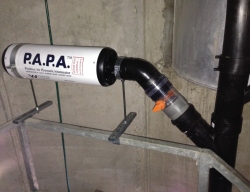High-rise soil drainage put to the test

Public-health engineers are well aware of the problems that can be experienced with soil stacks in high-rise buildings. A 40-storey demonstration and test rig at the National Lift Centre in Northampton (adjacent picture) has attracted lots of visitors, including Ken Sharpe.
Just 50 mm or so of water in the bottom of a toilet pan is all that separates the inside of a building from its soil drainage system and the sewerage system that it feeds into. If that trap should be lost because of negative pressure in the stack or, messy, because it is blasted out of the bottom of the WC pan by a sudden surge of high pressure in the stack, the protection is lost.
But as Steve White, technical director with Studor, which specialises in active venting for soil stacks, points out, the test rigs for such drainage systems are nowhere near as high than many buildings in the world and can hardly be relied on to provide adequate design guidance for taller buildings.
The standard BS 5572:1994 — Code of practice for sanitary pipework, for example, is based on information from BRE’s 5-storey test rig at Garston. There is a 10-storey facility in Germany, and this is the tallest in Europe.
There are plenty of well-known examples of tall buildings with drainage problems around the world, so the opportunity presented by Studor’s partner Polypipe Terrain to see how a 40-storey demonstration rig with and without active ventilation performs was eagerly taken up by dozens of public-health engineers during the summer.
The rig is in the National Lift Tower at Northampton, a stark concrete structure that is 127 m high and erected as a purpose-build lift-testing tower. It was built in the early 1980s and is known locally as Northampton Lighthouse. It has been a Grade 2 listed building since 1997.
 |
| Fig. 1: Looking up the fire escape in the National Lift Centre, showing the test rig. |
The tower has six lift shafts and, importantly to Polypipe Terrain and Studor, a fire escape down the centre with a metal staircase and space round it in which a single straight soil stack and a variety of equipment such as sinks and toilet pans have been installed (Fig. 1). Some sections of the stack are clear so that activity inside can be observed.
Two types of device to quickly dissipate the sudden changes in pressure (positive and negative) that can occur when a toilet pan is flushed, or several are flushed at the same time, have been installed.
One is automatic air vents to admit air into the system if there is negative pressure that might suck the water trap out of a toilet pan. Such vents open at a negative pressure of 7 mm of water (70 Pa)The other is PAPAs (a tradename meaning positive air pressure attenuators) to absorb the effect of back pressure (positive) that could blast water out of traps. Their function is to slow down the speed of back pressure from a potential 320 m/s to 12 m/s and prevent water being blasted out of traps.
Valves enable both devices to be isolated or made effective for demonstration purposes.
There are 10 toilet pans on the stack with a height difference of nearly 100 m. Tests have been carried out with up to 60 litres of water discharged into the system in less than 15 seconds and with solids, wet wipes and sanitary towels.
Steve White believes that this is the tallest tower in the world that has undergone testing of a drainage system.
Public-health engineers seeing the test rig in action seem to have had their perceptions changed, as illustrated by the following comments.
• ‘I think I have got it wrong in the past.’
• ‘I’ll have to look at my designs more closely from now on.’
• And in response to a video showing what happened to one WC pan when all 10 were flushed with active ventilation disabled: ‘I wouldn’t want to be sat on that if that happens!’
Steve White believes that high-rise buildings are not well understood and can point to a number of iconic buildings around the world that have suffered serious drainage issues, arguing that active ventilation is a proven solution — and something that can be added to existing systems. Indeed, he believes that current codes do not address the requirements of high-rise buildings.
His concern is that engineers consider only the movement of liquids and solids in a drainage system, not the resulting air movement.
 |
| Sudden surges in pressure in a tall soil stack can be safely absorbed by positive air pressure attenuators strategically placed throughout a system. |
The distances involved in passive ventilation can be very great indeed in a large system, so that changes in pressure cannot be dissipated quickly enough. AAVs and PAPAs provide localised intervention that is very much quicker. The key is to avoid pressure differences greater than 400 Pa above or below atmospheric pressure — that being the point at which air passes through the water trap seals.
Trying to control and balance air pressure with systems having two or three vertical stacks of 110 mm diameter each requires enormous quantities of pipe. A pallet of AAVs and PAPAs can readily replace a container of pipework.
The test rig at Northampton Lighthouse is likely to stay in place for some time yet, and Polypipe Terrain periodically host open days.
The best contact is Steve White at Studor (steve@studor.net)







